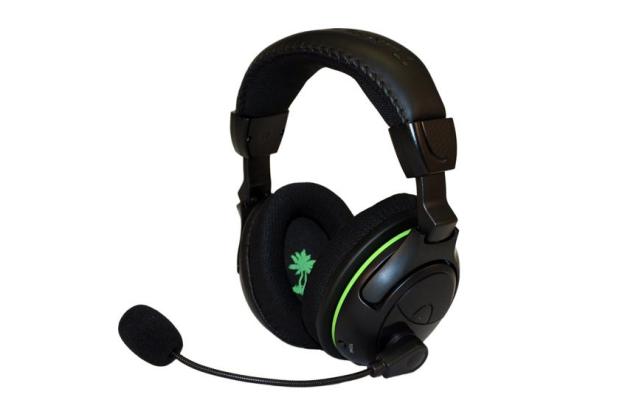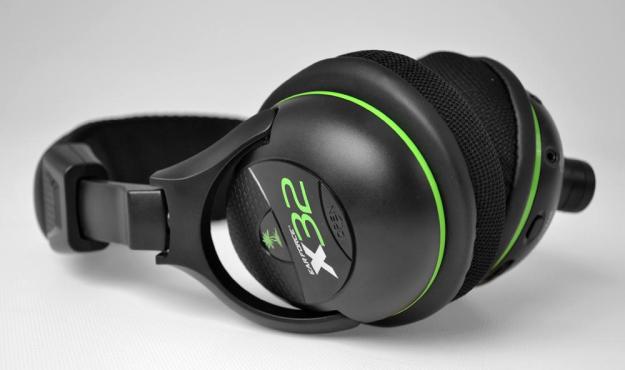
“The X32 headset carries on Turtle Beach’s high standard for design and audio quality. The only significant down side to these otherwise well built headphones is their tenuous wireless range.”
- Terrific sound quality
- Handy auxiliary input
- Four EQ presets
- Comfortable for long-term use
- Auto-off conserves battery life
- Persistent buzz in left channel
- Limited range, finicky transmitter
- Spatial expander effect is distracting
Also check out our review of the Turtle Beach Earforce X42 headset which brings Dolby Surround processing to the mix for an extra $60.
Turtle Beach pleasantly surprised us with its solid-sounding X12 wired gaming headset. Its audio quality surpassed our expectations and compared nicely against like-priced audio-only headphones. That got us wondering: Could Turtle Beach provide an equally satisfying sound experience in a wireless stereo headset? We contacted Turtle Beach and in no time at all we had a pair of the Ear Force X32 sitting at our desk.
The X32 replace last year’s X31 and bring with them some notable changes. Aside from looking quite a bit better than the X31, the X32 pack in bigger drivers, more advanced wireless transmission and several other nifty bells and whistles. Read on to find out how useful these new features really are, and whether the X32’s wireless audio can hold a candle to its hard-wired solutions.
Features and design
We expected the X32 might simply be a wireless version of the X12. It turns out, however, that you get a whole lot more than just a wireless transmitter out of the extra $40 it takes to get into the X32.
The X32’s wireless transmitter module offers an auxiliary input jack, allowing the user to listen to music from a portable media player — or audio from any other device, potentially an A/V receiver — even while gaming.
A “tone” button located on the front side of the left earcup cycles through four EQ settings. Through our listening tests we concluded setting one is flat, setting two boosts bass only, setting three boosts treble only and setting four boosts both bass and treble (like a loudness button).

The “sound field” button, located toward the rear of the left earcup, introduces a sort of “spatial” effect that seems to employ increasing amounts of reverb and phase effects. Setting one is off, setting two is medium (described by Turtle Beach as narrow) and setting three is high (described as wide). We’ll get into the nature of the effect and whether they match the manufacturer’s description in our performance section.
The X32 also offer an interesting feature it calls “Chat Boost” Essentially, this boosts and trims chat volume to coincide with the rise and fall of game play volume. In this way, users can set a level they are comfortable with, using the chat volume dial on the Xbox 360 talkback cable, and allow chat boost to manage things from there.
Whereas the preceding X31 model used 40mm drivers, the X32 use 50mm drivers. The wireless transmission technology has also been expanded to include the 5.8GHz band in addition to the standard 2.4GHz band found on the X31. According to Turtle Beach, the transmitter will pick the least congested frequency when pairing the transmitter to the headset. In theory, this would increase the chances of a clear transmission between the two.
Given that the X32 headset must accommodate two AAA batteries for power and store the amplifier internally, we expected them to bit a bit bulkier and heavier than the X12, but we were surprised to find that wasn’t the case. The headset appears to be almost identical in size and the weight difference is negligible.
Otherwise the X32 share the X12’s highly breathable earcup and headband material, the same clamping force and the same great fit.
Setup
While the lack of a wire tethering the headset to the Xbox 360 is a huge step in the right direction in terms of cleaning up the installation, it is still necessary to deal with a long run of analog RCA “piggyback” cables in order to get a sound signal from the console to the transmitter. At this level, a digital optical connection just isn’t an option.
Otherwise, setup was a piece of cake. With the audio cable connected, we pressed and held the “pairing” button on the right side of the transmitter until its blue LED flashed. We then pressed and held the power button on the left side of the X32 headset until we got the pairing beep. Within seconds, the two were paired and ready to go. For fun, we also connected our iPhone via 3.5mm patch cable to the aux input on the rear of the transmitter. This would allow us to try several different music tracks with ease.
Audio quality
In terms of overall fidelity, the X32 are almost a dead-on match to the X12. In other words, we highly approve. Without any tonal adjustment, the X32 sound well balanced and natural, exposing a decent amount of recording detail — especially for a gaming headset. Bass wasn’t especially hearty, but certainly audible. Midrange was largely uncolored and the highs came through with tons of texture and just a touch of added brightness. Stereo effects were excellent, almost wrapping around our head to give a sense of surround sound.

One press of the tone button boosted the bass to a level that was much more to our liking. It had more authority and seemed to reach deeper than the flat setting allowed, although it could get a little overbearing with tracks that were heavy on bass. Another press of the tone button pulled the bass back and brightened up the treble to a level that we didn’t care for. On especially bright tracks, the boosted treble was almost intolerable for us. Naturally, then, the final EQ preset was still too hot in the highs while bass was back to the level we liked. We ended up using the bass boost only setting for 90 percent of our testing but we appreciate the ability to make significant changes in order to accommodate for highly differed game sound mixes.
We weren’t as crazy about the sound-field expander feature. The intention may have been to enhance the sense of space in certain gaming situations; playing first person shooters, for example, can be made more immersive and fun when you know where your enemies are coming from and we think the spatial expander was intended to enhance the sense of spatial awareness. However, we found the effect more distracting than anything else. The sound of the headphones is so good with the feature turned off that we don’t see much of a point in messing around with it. If the track or game being listened to has any reverb of its own, the spatial expander has a way of reinforcing the effect to almost ridiculous levels.
Our only real complaint about the audio performance of the headphones has more to do with wireless technology than anything else. We got a consistent and constant low-level buzz in our left ear. It sounds like electrical interference and, though it is very quiet, its persistence and audibility during quiet music and gaming moments will likely annoy highly sensitive and easily aggravated listeners.
Wireless range and performance
Given that the X32 operate on either the 2.4GHz or 5.8GHz band in the same way that Wi-Fi routers and cordless phones do, we expected a pretty decent wireless range. It turns out, though, that the wireless connection between transmitter and headset is a little…well…sensitive.

First off, know that the X32 like line of sight… a lot. Moving around a corner cut the audio out for a second or so while the headset adjusted and reacquired the signal. From there, the audio was steady so long as we didn’t move. Once we did, audio would cut out again until we stopped moving long enough for the signal to reinstate. In a wide open room with no obstacles, we think you might be able to get 30 feet of range out of the system but, for many, that isn’t practical. Plan on staying in the same room as the transmitter.
Practically speaking, most gamers will be in the same room as their console and the headset’s transmitter. However, the finicky nature of the system has other implications. For instance, we found that trying to hide the transmitter within our entertainment cabinet cut the operational range by more than half. It also caused our headset to cut in and out with just slight movements of our head. This indicated to us that the system was struggling to maintain its connection just as it had when we moved around corners and into different rooms separated by walls. Our recommendation is that users plan to place the transmitter in an open, elevated position to provide for the best wireless range.
Overall
The X32 headset carries on Turtle Beach’s high standard for design and audio quality. These gaming cans sound fantastic playing music or games and offer some useful EQ adjustments as well as the option to add a second sound source. Thankfully, audio fidelity doesn’t suffer over the wireless connection, though there is a low-level buzz that will bother some listeners. The only significant down side to these otherwise well built headphones is their tenuous wireless range. Careful placement of the wireless transmitter is essential toward getting the most out of the X32.
Highs
- Terrific sound quality
- Handy auxiliary input
- Four EQ presets
- Comfortable for long-term use
- Auto-off conserves battery life
Lows
- Persistent buzz in left channel
- Limited range, finicky transmitter
- Spatial expander effect is distracting




